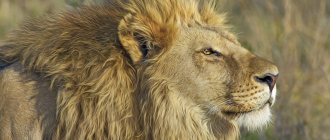- Reports and messages
- Animals
- African elephant
The elephant is the largest animal on earth.
The blue whale is larger than the elephant, but it lives in the ocean. There are two types of elephants on the planet: Indian and African. African elephants are larger than Indian elephants. In Africa, elephants live mainly in national parks. There they are protected from poachers who kill animals for their tusks. African sleep is very large and heavy. It weighs almost 8 tons and is 4 - 4.5 meters tall. Elephants can live up to 70 years. Adult elephants are not afraid of anyone in the wild. Even lions will not attack these large and strong animals. Only man is a dangerous enemy to the elephant.
Elephants live in herds of up to 20 individuals. They help each other. Strong elephants protect children and the elderly, as well as sick relatives. The most experienced elephant leads the herd. All family members listen to their leader. No one in the herd quarrels or fights.
Elephants eat a lot of plant foods. They can eat more than one hundred kilograms of grass, leaves, tree bark or fruit per day. They drink even more water: up to 200 liters per day. It takes them a lot of time to search for and eat food. Elephants sleep very little: 2-3 hours a day.
Elephants are born weighing up to 100 kilograms. Two hours after their birth they set off. In order not to lose the elephant, the baby holds onto her tail with his trunk. Until the age of three, the mother elephant feeds the baby with milk. But, after 1.5 years, elephant calves learn to eat adult food.
There are many interesting things related to elephants. For example, an elephant's trunk. With its help, the animal delivers food and water to the mouth. He washes himself by pouring water on himself. To prevent sunburn, the elephant sprinkles sand on itself. The trunk can be a breathing tube if the elephant is swimming underwater.
Elephants hear not only with their ears, but also with their feet. On the skin of these animals' limbs there are very sensitive areas of skin. Elephants will immediately detect that someone is approaching or running up to them.
Elephants' skin, although thick, is very sensitive. The animal will immediately feel when an insect lands on it. Elephants do not like wild bees and try not to encounter them.
They say that elephants are afraid of mice. This is wrong. A mouse cannot harm a big elephant.
People tame elephants and make them their helpers. Animals follow human commands. But if someone offends an elephant, he will remember it for a long time. Elephants have a very good memory.
To prevent these beautiful animals from becoming extinct like other giants, they must be protected and protected!
1st, 2nd class, in the surrounding world
Elephants: description
These animals represent the Elephantidae family and the Proboscidea order. Elephants can be easily distinguished from other animal species by their large ears and trunk, which the animals use as a hand. Older individuals also have tusks, as one of the main attributes of elephants. They are considered valuable, so poachers hunt for the tusks to sell them for big money.
Appearance
All elephants, compared to other species of animals, are characterized by large sizes, since depending on the variety, their height ranges from 2 to 4 meters. On average, these animals grow up to 4 and a half meters in length, although in nature there are individuals whose body length is more than 7 meters. Their weight also depends on the species, so elephants can weigh from 7 to 12 tons. The body is characterized by an elongated shape, while the main color of the skin can vary from gray to gray-fawn. Elephants' skin is dense, uneven, consisting of folds and bumps, up to 2 centimeters thick, and it is devoid of sweat and sebaceous glands. There is also no hair, and if it is present, it consists of sparse and short bristles. Newborn babies have hair, but over time it breaks off or falls out.
Interesting moment! Elephants often bathe and throw mud on themselves. The crust of mud that appears on the skin reliably protects these animals from the sun and annoying insects.
Elephant ears also play a fairly important role in providing these animals with comfortable living conditions. Since the ears are large and very mobile, elephants use them to cool their skin and also drive away ubiquitous insects. The size of the ears depends on the species. And also on living conditions: elephants living in warmer regions have larger ears and vice versa. The skin of elephants does not have sweat glands, with the help of which thermoregulation of the entire body is usually carried out, so these functions are fully performed by their (comparatively) huge ears. Compared to the rest of the body, the skin of the ears is quite thin and dotted with many capillaries, so the blood cools much faster and cools the entire body. In addition, in the area of the ears there is a special gland, which secretes a special secretion during the mating season, and the ears help spread this secretion over a considerable distance, attracting individuals of the opposite sex.
Interesting moment! The pattern of capillaries piercing the ears of elephants has an individual pattern for each individual.
The animal's trunk is formed by the nose, as well as the upper lip of the mammal. It is difficult to even imagine what an elephant would do without this rather important organ. The elephant's trunk is quite muscular and strong, and it also serves as an organ of smell for it. With its help, the elephant examines various objects, plucks grass, as well as branches of various trees, vegetables and fruits, providing itself with food. The nose allows this animal to suck in water, and also serves as a natural hose, thanks to which it sprays itself with water, cooling the body in extreme heat. Moreover, thanks to such a universal instrument, the elephant is able to make various sounds. On this large organ, namely at its end, there is a small process in the form of a finger, which has no worse functionality.
Elephants' limbs are thick, columnar, armed with five fingers connected by common skin. In addition, each foot has hooves, and the center of the foot is formed as a pad of fat. When this massive living creature walks, the fat pad is flattened and the area of the foot increases, thereby reducing the load on the limbs. In addition, these giants walk almost silently. The structure of the limbs is such that the legs have two kneecaps, which deprives these animals of the ability to jump, although it is difficult to even imagine that such giants could also jump. Elephants' teeth undergo a constant process of replacement.
Only the upper third incisors are not subject to change, which over time grow into huge tusks, because of which these animals suffer the most. Female Asian elephants do not have such tusks. Although the tusks are constantly growing, they are also constantly being worn out. The more tusks an elephant has, the older the animal is. The length of the tail is commensurate with the length of the limbs, while the tail ends with a fairly rigid brush. With the help of this brush, elephants protect themselves from various insects by waving their tail like a fly swatter. Young individuals, moving as part of a group, hold on to the tail of their mother or nanny.
ELEPHANT - INTERESTING FACTS
Character and lifestyle
As a rule, elephants form small groups, although their number can be dozens of individuals. At the head of such a group is an adult and quite wise female. If she dies, she is replaced by the second oldest female, who may represent a sister or daughter, although this fact is not important since all individuals representing a particular group of animals are related. Basically, the group consists of females and their offspring, and males, when they grow up, are simply expelled from the herd. Despite this, males try to stay close to the group. Females tolerate the opposite sex in their group only during the mating period.
Members of family groups are well aware of their responsibilities. They have a well-developed sense of responsibility, as well as mutual assistance and assistance. Each group has a kind of nursery, kindergarten and school. They treat each other with love, raise and educate their growing offspring together, and if one of them dies, they suffer greatly. When they move through a certain area, they may encounter the remains of an elephant. Even if this elephant did not belong to their herd, a group of elephants stops and freezes, as if honoring the memory of a dead relative. Moreover, elephants have developed a certain ritual for burying their dead brothers. When an animal dies, its brothers carry it to the pit, throw branches and stones at it, and then blow a trumpet, as if bidding farewell to it. There were cases when elephants buried people who died for some reason in the same way. In this case, elephants can remain near the grave for several days.
African elephants rest at night, leaning against each other. Adult males rest, placing their heavy tusks on some hill. Indian elephants rest lying on the ground. Animals can sleep up to 4 hours a day, while African elephants sleep for 40 minutes, followed by a short break, and then another forty-minute rest. When elephants are not resting, they are in constant motion, finding food for themselves or caring for group members.
Elephants' vision is not particularly acute, but their hearing and sense of smell are simply excellent. Zoological scientists have found that elephants are able to communicate using infrasounds at an impressive distance from each other, despite the fact that elephants are capable of making a wide variety of sounds when communicating with each other. At first glance, it seems that these animals are inactive and inept due to their enormous size and weight, but this is not at all the case, since they are quite mobile, but also quite cautious living beings. Their movements are leisurely, but when accelerating, they are able to run at speeds of up to 40 km/h. In addition, elephants can easily overcome water obstacles by swimming, with only their trunk above the surface of the water.
How long do elephants live?
Being in natural conditions, elephants live up to 70 years, while in captivity their life expectancy increases by an average of 10 years if comfortable living conditions are created.
Elephant intelligence
The brain volume of elephants is not so large compared to the size of the animals themselves, but this fact is not an obstacle to considering this family the smartest animal on the planet. They even have self-awareness, since animals recognize themselves in the mirror. They, like monkeys, use various objects as tools to achieve their goals. These animals quite often use tree branches as a fan to cool their bodies, or as a fly swatter to protect themselves from annoying insects. Elephants have a unique visual, auditory and olfactory memory, which allows them to remember vast territories, as well as places of watering and feeding. They easily remember people, as well as their relatives, recognizing them after a long separation. These animals tolerate conditions of captivity patiently, but do not like to be poorly cared for and treated poorly. As a result, they are capable of going berserk, destroying everything in their path. Elephants, according to scientists, are capable of various experiences, such as sadness, sadness, joy, rage, anger, etc. According to them, elephants can laugh.
Interesting moment! There are elephants, like people, both right-handed and left-handed, as evidenced by the sharpening of their tusks. As a rule, tusks wear down more on the side on which the animal uses them more.
Being in captivity, elephants are easy to train, so elephants have always taken part in circus performances. In India, elephants are used for various types of work. There is an elephant football championship in Thailand.
Savannah Animals Wild Africa Amazing Elephants Nat Geo WILD
Types of elephants with photos
Nowadays, it is known that there are 4 species of elephants in the wild, which form 2 genera - African and Indian elephants. There is ongoing debate among experts as to whether individual subspecies should be considered separate subspecies or included in a general subspecies. Nowadays, there are the following types of elephants:
- The genus African elephant , which includes savannah and forest elephants as separate species.
- The genus of Indian elephants , consisting of such subspecies as the Bornean elephant, the Sumatran elephant and the Ceylon elephant.
African elephants differ from their Indian relatives in a number of external characteristics. Indian elephants' ears are smaller in size, more noticeable, and at the same time they have a more broken shape, while African elephants have rounded ears. African elephants grow tusks in both males and females, and by the size of the tusks one can distinguish males from females, since in females they are thinner and shorter. Indian elephants have comparatively thinner and shorter tusks. The structure of the trunk is also different: Indian elephants have only one “finger” at the end, while African elephants have two. In African elephants, the head rises slightly above the level of the body, while in Indian elephants it is slightly lowered and below shoulder level.
Forest elephant (Loxodonta cyclotis)
Forest elephants represent the genus of African elephants, although they were previously classified as a subspecies of savannah elephants. The height of these animals is no more than 2 and a half meters, while their body is covered with fairly thick hair. The ears are massive, round in shape. The main color is gray-fawn with a brown tint, formed due to the color of the coat.
Savannah elephant (Loxodonta africana)
Savannah elephants are noted in the Guinness Book of Records as the largest land mammals living on our Planet, but second in size only to two species of animals. The height of the mammal at the withers reaches 4 meters, with a weight of about 6 tons. Males are larger than females and their tusks are longer.
Indian elephant (Elephas maximus)
Indian elephants are considered the second largest animals representing this family. Compared to African elephants, the body of these animals is more massive, although the legs are milder and thicker. Their heads are lowered, as are their ears, which are smaller in size when compared to the ears of African elephants. The back is humped and convex, and there are also two protuberances on the forehead. There are non-pigmented areas on the skin that form pink spots. Among this species there are albino elephants, which are used as objects of worship.
Ceylon elephant (Elephas maximus maximus)
Ceylon elephants are a subspecies of Asian elephants and grow up to 3 meters in height. These elephants do not have tusks, regardless of their gender. In relation to the body, the head of these animals is quite large, and a discolored spot can be seen at the base of the trunk and in the forehead area.
Sumatran elephant (Elephas maximus sumatrensis)
Sumatran elephants rarely grow to 3 meters in height and have virtually no tusks.
Bornean elephant (Elephas maximus borneensis)
Bornean elephants are considered a dwarf species because they are characterized by the smallest size, but they have a relatively thick and long tail that reaches almost to the ground. The hump on the back is more noticeable, as are the tusks, which do not have a pronounced curve.
Tusks
Both male and female African elephants have tusks, which are modified incisor teeth. Although elephants have them from birth, they fall out after the first year of life, after which full-fledged tusks grow in their place for life. They grow constantly throughout the animal's life. Like the trunk, tusks are used by elephants to perform a variety of activities. They are used for digging, foraging and fighting. At times they are also used by the elephant as a place where he can rest his trunk, tired from the day's activity.
Dresses, stockings, fans with pearls: the Hermitage donated a collection to the Historical Museum
To avoid harm to health: choose frying oil with a high smoke point
She was called the Russian Monroe: how the life of the beautiful actress Natalia Lapina turned out
Habitat
African elephants are called African elephants because they live on the African continent, including the territories of countries such as Sudan, Namibia, Kenya, Zimbabwe and others. Indian elephants are called Indian elephants because their habitat extends to the northeastern and southern regions of India, as well as Thailand, China, Vietnam, etc. Basically, their habitat is in protected areas, since all subspecies are listed in the Red Book. African elephants prefer to live in savannas, which are characterized by the presence of shady areas, while they avoid open areas, as well as landscapes overgrown with dense vegetation.
Elephants can be found without problems in primary deciduous forests, as well as in tropical rainforests. Part of the population prefers to live in the dry savannas of Namibia, as well as in the southern regions of the Sahara, but this should be considered more of an exception to the rule. Indian elephants prefer areas of plains covered with tall grass, as well as various shrubs, including areas with bamboo thickets. The main thing is that there is water somewhere nearby. It is very important for elephants to drink water at least once every couple of days; in addition, elephants need daily water procedures.
What do they eat?
For normal life of elephants, they must consume up to half a ton of food items daily, which are mainly plant objects. They happily eat grass, wild plants, as well as their fruits, in the form of fruits and berries. African elephants are skilled at using their tusks, stripping the bark of baobabs and other trees. Indian elephants love to eat ficus leaves and also raid cultivated plantings of sweet potato and corn.
To provide their bodies with the necessary amount of salt, elephants find licks that come to the surface of the earth or dig them out from under the ground. By eating the bark and wood of various trees, elephants replenish the necessary amounts of vitamins and minerals. When elephants are kept in captivity, they are fed a variety of foods and given sweets as rewards. Often, captive elephants are overfed with carbohydrates, which causes them to develop health problems, as their metabolism is disrupted and problems with the functioning of the gastrointestinal tract begin.
Test on the topic
- /5
Question 1 of 5On what continent does the African elephant live?
Start test
Hall of Fame
To get here, take the test.
- Alexey Dreamkach
0/5
- Maria Mikhailova
5/5
- Ilkhamia Basyrova
5/5
- Lisa Ancherbak
5/5
Reproduction and offspring
The mating process of elephants does not have any seasonal restrictions, so females mate with males when they are ready for this process. As a rule, during periods of readiness to mate, males are capable of unmotivated aggression. Their glands, located in the ear area, secrete a special secretion that spreads in the air for many kilometers, signaling their readiness to mate. This condition of elephants in India is called must.
Important point! In this state, males are the most aggressive. Therefore, they can attack people.
When the females are ready to mate, they move away from their group and begin to make loud sounds that can be heard for many kilometers around. The males, hearing the calling roar of the females, head to her location, where they begin to fight for the right to fertilize the female. Such fights do not pose any threat to the life of the males, since they compete to appear larger by spreading their ears and making loud noises. Therefore, the challenger is larger and louder. If they fail to identify a larger and louder male, they begin to cut down trees and lift their trunks. Showing off your strength. The strongest can drive away other contenders for many kilometers.
After mating, females carry their future offspring for an average of 20 weeks. The offspring are born in the company of other, more experienced females, who are always ready to help and protect from natural enemies. Mostly one baby elephant is born, but there are cases of twins being born. The weight of a newborn is comparable to that of an adult. Within a couple of hours after birth, the baby gets to his feet and begins to drink mother's milk. After birth, the whole family makes loud noises, welcoming it and announcing to the whole world about the addition of the family.
Interesting to know! Elephants have nipples on their front legs, like primates, and not in the groin of their hind legs, like most mammals.
Elephant calves feed on their mother's milk for two years, while a calf can feed from any female who is nursing her growing offspring. Despite this, after only six months of life, baby elephants begin to get used to plant foods.
Elephants are looked after by the entire family until the age of five, and family affection remains for life. After this, the males are expelled from the herd, and the females remain to make up for the natural losses of the family. Around 10 years old, elephants become sexually mature.
Communication
Communication is vital for elephants, which rely on social connections for survival. The basic social unit is the herd, consisting of mothers and their children, sisters and other related females, led by the eldest female matriarch. Males leave the herd after puberty, that is, at about the age of fourteen years. They join a free group of other males and leave it of their own accord when they begin searching for a female to continue the race.
Malaysian artist creates stunning surreal photo illusions
A little epoxy, a couple of boards - and the illuminated table is ready: simple instructions
The first country in the world to vaccinate its entire population against Covid
Natural enemies of elephants
Adults have virtually no enemies in nature. Since it is unlikely that any predator can attack this strong and powerful animal. Young elephants or newborns are most susceptible to attacks, although this does not happen as often. Man was and is considered the main enemy of elephants, although he also does everything to prevent elephant populations from declining.
ELEPHANT IN ACTION! Elephant against lions, crocodiles, rhinoceroses...
Man and elephants
Elephants are such unique living beings that humans cannot take advantage of them, both in the good and bad sense of the word. Despite security measures, elephant ivory has not lost its value even today, so poachers take advantage of this and do not stop hunting elephants.
In many Asian countries, as well as in India, elephants are used as a powerful labor force, and often young elephants are removed from their natural habitat without thinking about the consequences.
Secrets of the life of elephants (documentary film)
Interesting Facts
People often ask which elephant can be trained, African or Indian, only the second can be trained; the wild nature of elephants from Africa does not allow them to be trained. There are many other interesting facts associated with these animals:
- the largest elephant weighed 11 tons and was killed in Angola in 1956;
- animals have good memory and a developed communication system;
- An adult elephant's trunk contains up to 8 liters of water at a time.











